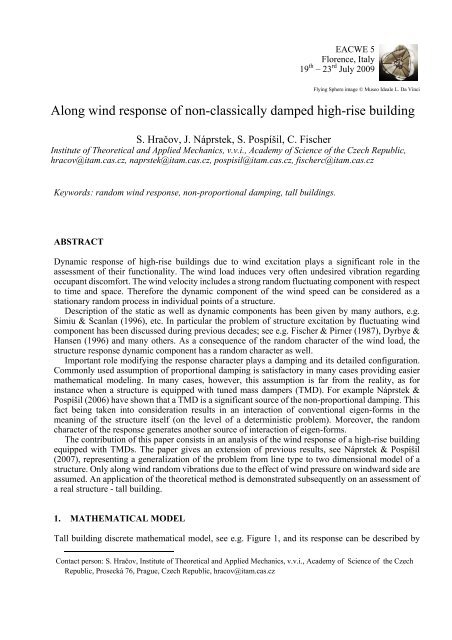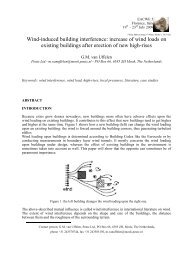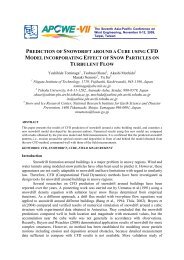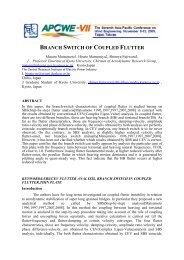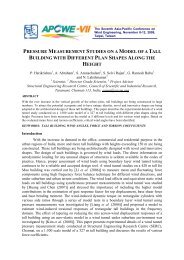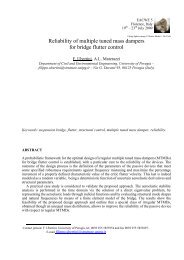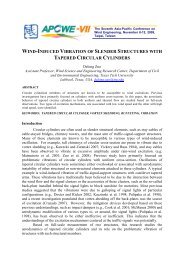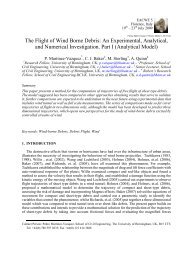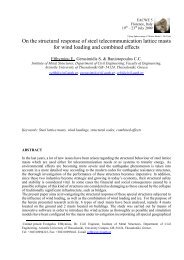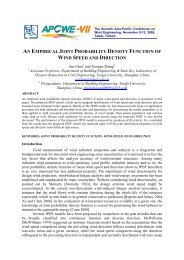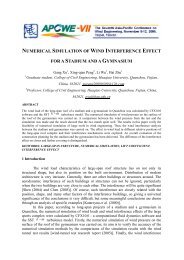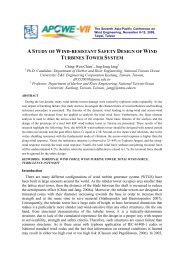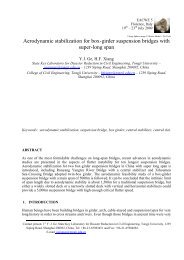Along wind response of non-classically damped high-rise building
Along wind response of non-classically damped high-rise building
Along wind response of non-classically damped high-rise building
Create successful ePaper yourself
Turn your PDF publications into a flip-book with our unique Google optimized e-Paper software.
EACWE 5<br />
Florence, Italy<br />
19 th – 23 rd July 2009<br />
Flying Sphere image © Museo Ideale L. Da Vinci<br />
<strong>Along</strong> <strong>wind</strong> <strong>response</strong> <strong>of</strong> <strong>non</strong>-<strong>classically</strong> <strong>damped</strong> <strong>high</strong>-<strong>rise</strong> <strong>building</strong><br />
S. Hračov, J. Náprstek, S. Pospíšil, C. Fischer<br />
Institute <strong>of</strong> Theoretical and Applied Mechanics, v.v.i., Academy <strong>of</strong> Science <strong>of</strong> the Czech Republic,<br />
hracov@itam.cas.cz, naprstek@itam.cas.cz, pospisil@itam.cas.cz, fischerc@itam.cas.cz<br />
Keywords: random <strong>wind</strong> <strong>response</strong>, <strong>non</strong>-proportional damping, tall <strong>building</strong>s.<br />
ABSTRACT<br />
Dynamic <strong>response</strong> <strong>of</strong> <strong>high</strong>-<strong>rise</strong> <strong>building</strong>s due to <strong>wind</strong> excitation plays a significant role in the<br />
assessment <strong>of</strong> their functionality. The <strong>wind</strong> load induces very <strong>of</strong>ten undesired vibration regarding<br />
occupant discomfort. The <strong>wind</strong> velocity includes a strong random fluctuating component with respect<br />
to time and space. Therefore the dynamic component <strong>of</strong> the <strong>wind</strong> speed can be considered as a<br />
stationary random process in individual points <strong>of</strong> a structure.<br />
Description <strong>of</strong> the static as well as dynamic components has been given by many authors, e.g.<br />
Simiu & Scanlan (1996), etc. In particular the problem <strong>of</strong> structure excitation by fluctuating <strong>wind</strong><br />
component has been discussed during previous decades; see e.g. Fischer & Pirner (1987), Dyrbye &<br />
Hansen (1996) and many others. As a consequence <strong>of</strong> the random character <strong>of</strong> the <strong>wind</strong> load, the<br />
structure <strong>response</strong> dynamic component has a random character as well.<br />
Important role modifying the <strong>response</strong> character plays a damping and its detailed configuration.<br />
Commonly used assumption <strong>of</strong> proportional damping is satisfactory in many cases providing easier<br />
mathematical modeling. In many cases, however, this assumption is far from the reality, as for<br />
instance when a structure is equipped with tuned mass dampers (TMD). For example Náprstek &<br />
Pospíšil (2006) have shown that a TMD is a significant source <strong>of</strong> the <strong>non</strong>-proportional damping. This<br />
fact being taken into consideration results in an interaction <strong>of</strong> conventional eigen-forms in the<br />
meaning <strong>of</strong> the structure itself (on the level <strong>of</strong> a deterministic problem). Moreover, the random<br />
character <strong>of</strong> the <strong>response</strong> generates another source <strong>of</strong> interaction <strong>of</strong> eigen-forms.<br />
The contribution <strong>of</strong> this paper consists in an analysis <strong>of</strong> the <strong>wind</strong> <strong>response</strong> <strong>of</strong> a <strong>high</strong>-<strong>rise</strong> <strong>building</strong><br />
equipped with TMDs. The paper gives an extension <strong>of</strong> previous results, see Náprstek & Pospíšil<br />
(2007), representing a generalization <strong>of</strong> the problem from line type to two dimensional model <strong>of</strong> a<br />
structure. Only along <strong>wind</strong> random vibrations due to the effect <strong>of</strong> <strong>wind</strong> pressure on <strong>wind</strong>ward side are<br />
assumed. An application <strong>of</strong> the theoretical method is demonstrated subsequently on an assessment <strong>of</strong><br />
a real structure - tall <strong>building</strong>.<br />
1. MATHEMATICAL MODEL<br />
Tall <strong>building</strong> discrete mathematical model, see e.g. Figure 1, and its <strong>response</strong> can be described by<br />
Contact person: S. Hračov, Institute <strong>of</strong> Theoretical and Applied Mechanics, v.v.i., Academy <strong>of</strong> Science <strong>of</strong> the Czech<br />
Republic, Prosecká 76, Prague, Czech Republic, hracov@itam.cas.cz
very well known system <strong>of</strong> differential equations <strong>of</strong> the second order :<br />
( t) ( t) ( t) ( )<br />
Mu ⋅ + Cu ⋅ + Ku ⋅ = pt . (1)<br />
Analysis <strong>of</strong> the random <strong>response</strong> is based on a transformation <strong>of</strong> the governing system (1) into<br />
generalized coordinates. Using orthonormal eigen-forms u 0 <strong>of</strong> the un<strong>damped</strong> system as a Galerkin set<br />
for a solution <strong>of</strong> Eq. (1):<br />
n<br />
∑<br />
() t = ⋅f<br />
()<br />
u u t . (2)<br />
j=<br />
1<br />
0 j<br />
j<br />
The above Eq. (1) can be rewritten in a normal form (2n-number <strong>of</strong> DOFs respected):<br />
( t) = ⋅ ( t) + ( )<br />
F Q F P t ,<br />
2n×<br />
2n<br />
F () t ,Q∈<br />
,<br />
2n<br />
P()<br />
t ∈ , (3)<br />
F<br />
() t<br />
() t<br />
() t<br />
⎡f<br />
⎤<br />
= ⎢<br />
⎢ ⎣f ⎥,<br />
⎥ ⎦<br />
Q<br />
⎡<br />
= ⎢ −<br />
2 −<br />
⎣<br />
0 I<br />
⎤<br />
Θ B ⎥ , P() t = ⎢ ⎥⋅ p() t = H⋅<br />
() t<br />
I<br />
⎦<br />
⎡0⎤<br />
⎣ ⎦<br />
p , (4)<br />
Θ<br />
2 2<br />
diag 1<br />
= [ Θ ,..., Θ ]<br />
2 n , 0 T<br />
B= u ⋅C⋅u 0 , u0 = [ u01,..., u 0n]<br />
. (5)<br />
In Eqs (2-5) we have denoted: f(t) – time functions representing the movement in generalized<br />
coordinates; p(t) - vector representing <strong>wind</strong> load adjoined to individual components <strong>of</strong> the vector f(t);<br />
Θ 2 - diagonal matrix containing squares <strong>of</strong> eigen-values <strong>of</strong> the un<strong>damped</strong> system; B - reduced<br />
damping matrix C; u 0j - j-th eigen-form <strong>of</strong> the un<strong>damped</strong> system.<br />
In the next step the eigen-values ξ j and eigen-forms q j <strong>of</strong> the system (3) should be evalueted<br />
according for instance to Fischer (2000). The solution algorithm is based on the same principle as the<br />
subspace iteration in the case <strong>of</strong> a symmetric real matrix. One iteration cycle consists essentially in<br />
complex inverse vector iteration and orthogonalization <strong>of</strong> the iteration vectors.<br />
2. ANALYSIS OF RANDOM RESPONSE<br />
Assuming the input and output processes in Eq. (3) in the form with spectral differentials <strong>of</strong> white<br />
noise type processes dФ(ω):<br />
∞<br />
iωt<br />
*<br />
p() t e dΦ ( ω)<br />
, () t ( ω,<br />
t) d ( ω)<br />
= ∫<br />
−∞<br />
Their correlations are given by Wiener-Kchintschin relation:<br />
∞<br />
F = ∫ F Φ . (6)<br />
−∞<br />
⎧ T ⎫<br />
E⎨dΦ( ω) ⋅ dΦ ( ω′ ) ⎬= dir( ω′<br />
−ω) S p ( ω)<br />
dω⋅ dω′<br />
. (7)<br />
⎩<br />
⎭<br />
E{.} is the mathematical mean operator with respect to the Gaussian probability density function.<br />
*<br />
n×<br />
n<br />
Matrix F ( ω,<br />
t)<br />
∈ 2 2 is a matrix <strong>of</strong> deterministic functions describing transformation <strong>of</strong> random<br />
excitation in generalized coordinates to individual components <strong>of</strong> the random <strong>response</strong> in time. S p (ω)<br />
is the spectral density matrix <strong>of</strong> processes p(t). Inserting Eqs (6) into the system (3) and applying the<br />
mathematical mean operator one obtains:<br />
∞<br />
∫<br />
−∞<br />
( * ( ) * ( ))<br />
∞<br />
i t<br />
F ω, t + Q⋅F ω, t ⋅Sp( ω) ⋅ dω= H⋅Sp( ω)<br />
⋅e ω dω. (8)<br />
∫<br />
−∞
Change sequence <strong>of</strong> the mean operator and the integration is allowed due to the independence <strong>of</strong> the<br />
spectral differentials dΦ<br />
( ω)<br />
. The formula (8) should be fulfilled in every moment t. Therefore it<br />
holds:<br />
* *<br />
i t<br />
F ( ω, t) + Q⋅ F ( ω,<br />
t)<br />
= H⋅e ω<br />
*<br />
, ( t)<br />
F ω , | = = 0 . (9)<br />
If the eigen-values <strong>of</strong> matrix Q are unique, the solution <strong>of</strong> Eq. (9) can be given using Laplace<br />
transform (t→ξ) in the form:<br />
2n<br />
*<br />
−1<br />
k<br />
⎛ 1 1 ⎞<br />
FL<br />
( ωξ , ) = ( Q+ I⋅ ξ)<br />
H = ∑ ZH<br />
⎜ − ⎟. (10)<br />
ξ −iω iω−ξk<br />
⎝ξ −iω ξ −ξk<br />
⎠<br />
k=<br />
1<br />
Matrix Z k ( 2n×2n) is expressed in a form <strong>of</strong> diadic product:<br />
T<br />
Zk = qkR ( ) ⋅q kL ( ). (11)<br />
The vectors q k(L) and q k(R) are the k-th normalized left and right eigen-forms <strong>of</strong> matrix Q respectively,<br />
while ξ k is the k-th eigen-value <strong>of</strong> matrix Q. For subcritically <strong>damped</strong> eigen-forms the eigen-values<br />
form complex conjugate pairs with negative real parts. Inverse transform <strong>of</strong> Eq. (10) results in:<br />
2n<br />
* 2 k ωt<br />
ξ<br />
( ,<br />
kt<br />
ω t) = ∑ ZH i<br />
F ( e e )<br />
k=<br />
1<br />
iω−ξ<br />
k<br />
t<br />
0<br />
− . (12)<br />
The first term in Eq. (12) characterizes the stationary <strong>response</strong> part, while the second one the<br />
influence <strong>of</strong> the initial transition effect. Due to the negative real part <strong>of</strong> ξ k , the second term is<br />
approaching to zero with increasing time and can be neglected.<br />
The correlation matrix <strong>of</strong> the <strong>response</strong> is derived using definition as follows:<br />
⎧ ∞<br />
∞<br />
⎪ * T T*<br />
{ } ∫ ( ω ) ( ω ) ∫ ( ω ) ( ω , )<br />
⎫<br />
T<br />
⎪<br />
KF<br />
( t1, t2) = E F( t1) F ( t2)<br />
= E⎨ F 1,<br />
t1 dΦ 1 dΦ 2 F 2 t2<br />
⎬=<br />
⎪⎩−∞<br />
−∞<br />
⎪⎭<br />
∞<br />
∫<br />
T<br />
( ) ( )<br />
* *<br />
1 p<br />
2<br />
= F ω, t ⋅S ( ω) ⋅F<br />
ω, t ⋅dω.<br />
−∞<br />
With respect to Eq. (12) the stationary state <strong>of</strong> Eq. (13) can be expressed in the form:<br />
F<br />
()<br />
( )<br />
∞ 2n<br />
T T T<br />
i t k k p l l<br />
t e ω q ⋅q ⋅H⋅S ω ⋅H ⋅q ⋅q<br />
= ∫ ∑ ⋅<br />
−∞ kl , = 1 i k i l<br />
K ⋅ dω . (14)<br />
( ω−ξ )( − ω−ξ<br />
)<br />
To obtain the dispersion matrix quantification the time t in Eq. (14) should be put to zero. The square<br />
roots <strong>of</strong> diagonal items <strong>of</strong> dispersion matrix reveal to be the decisive values characterizing the<br />
<strong>response</strong> to the random excitation.<br />
The stochastic part <strong>of</strong> <strong>response</strong> u(t) is determined by the correlation function:<br />
n<br />
{ } ∑ E ( θ ) ( θ )<br />
( ) E ( ) ( )<br />
{ }<br />
K , , , , , ( ) , , ( )<br />
u PRt1 t2 = u Pt1 u Rt2 = u0i P⋅ fi i t1 fj j t2 ⋅u0j R =<br />
ij=<br />
1<br />
T<br />
0<br />
f 11 1 2<br />
0<br />
= u ( P) ⋅K ( t , t ) ⋅u<br />
( R).<br />
P and R stand for two arbitrary points <strong>of</strong> the structure. Matrix K f11 (t 1 ,t 2 ) denotes correlations between<br />
the functions f i (t) corresponding to eigen-form u 0i .<br />
(13)<br />
(15)
For the stationary case Eq. (15) can be rewritten as:<br />
T<br />
( ) f11<br />
K PRt , , = u ( P) ⋅K ( t) ⋅u ( R). (16)<br />
0<br />
u<br />
0<br />
3. EXCITATION DUE TO WIND TURBULENCE<br />
The random component <strong>of</strong> <strong>wind</strong> load is described by the spectral density S p (ω). The correlation<br />
matrix <strong>of</strong> the external load K p (t) is formulated by equation:<br />
T<br />
{ τ τ } { ∫ 0 ( ) ( , τ) P ( , ) ( )<br />
A<br />
∫ τ dA<br />
A<br />
}<br />
T<br />
() ( ) ( )<br />
K p t = E p p t + = E u P p P ⋅ dA p R t + u R 0 R<br />
⋅ . (17)<br />
Due to the linear character <strong>of</strong> integrative operator and the mathematical mean operator one obtains for<br />
Eq. (17):<br />
T<br />
T<br />
{ , , } ( ) ∫∫ ( ) ( , , ) ( )<br />
() ( ) ( τ) ( τ)<br />
∫∫<br />
K t = u P ⋅ E p P ⋅ p R t + ⋅ u R ⋅ dA dA = u P K P R t ⋅ u R ⋅dA dA<br />
p 0 0 P R 0 pu 0 P R<br />
A A<br />
AA<br />
∫∫ u 0( P) K pu ( P, R, t) u T<br />
0 ( R)<br />
dAP dAR<br />
. (18)<br />
A A<br />
= ⋅<br />
After the Fourier transformation <strong>of</strong> Eq. (18) it results in:<br />
( ω) ( ω)<br />
∫∫<br />
T<br />
p = 0( P) ⋅S pu P, R, ⋅ 0( R)<br />
⋅dAPdAR<br />
A A<br />
H H B B<br />
T<br />
0( zP, xP) S pu( zP, zR, xP, xR, ω ) 0( zR, xR)<br />
dzPdzRdxPdxR<br />
0 0 0 0<br />
S u u =<br />
∫ ∫ ∫ ∫ u u . (19)<br />
= ⋅ ⋅ ⋅<br />
The spectral density S pu (P, R, ω) describes correlation <strong>of</strong> the <strong>wind</strong> pressures between points P and R<br />
<strong>of</strong> the structure. Only the along <strong>wind</strong> pressure component is considered. The spectral density<br />
S pu (P,R,ω) is defined by:<br />
2 2<br />
( ω) ρ<br />
S PR , , = c vv AA ⋅G ( ω)<br />
⋅ χ χ . (20)<br />
pu D P R P R vv z x<br />
The function G vv (ω) represents Davenport’s spectral density <strong>of</strong> the <strong>wind</strong> speed’s fluctuation, see<br />
Davenport (1967). Coefficients χ x resp. χ z are aerodynamic admittances that describe space<br />
correlation <strong>of</strong> the pressure on acting <strong>wind</strong>ward area. After substitutions Eq. (20) becomes:<br />
2 2 2 2<br />
− ( Cx xP− xR ) + ( Cz zP−zR<br />
)<br />
2 2 v10<br />
⋅Ω v10<br />
2π<br />
pu ( PRω)<br />
= cDρ<br />
vv P R AP AR<br />
⋅ K ⋅e<br />
2 4/3<br />
S , , 4<br />
ω(1 +Ω )<br />
ω<br />
. (21)<br />
where Ω = 1200ω/(2πv 10 ); K- the roughness coefficient; C x , C z - decay coefficients in respective<br />
directions; c D - drag coefficient; ρ - air density; v P - mean value <strong>of</strong> the <strong>wind</strong> speed in point P; v 10 -<br />
mean value <strong>of</strong> the <strong>wind</strong> speed in ten meters above the ground; A p - area corresponding to point P.
4. NUMERICAL ANALYSIS<br />
Figure 1: Prototype <strong>of</strong> a tall <strong>building</strong> and its FEM model with TMDs.<br />
The proposed theoretical procedure has been used for calculation <strong>of</strong> the <strong>response</strong> <strong>of</strong> the real 100 m<br />
<strong>high</strong>-<strong>rise</strong> <strong>building</strong> equipped with TMDs, see Figure 1. The TMDs are installed at the top <strong>of</strong> both<br />
towers and tuned to the first eigen-value <strong>of</strong> the basic system. The weight <strong>of</strong> each absorber is 200<br />
tones. The discrete mathematical model <strong>of</strong> structure is created in CALFEM, which is Matlab toolbox<br />
supporting the finite elements method application. The model consists <strong>of</strong> 62 nodes (including 2<br />
representing absorbers, each one with 1 degree <strong>of</strong> freedom). The dampers are modeled as<br />
concentrated masses with Kelvin-Voigt damping terms. The first four eigen-modes <strong>of</strong> the system<br />
obtained from modal analysis are depicted in the Figure 2. The random <strong>wind</strong> load is defined by the<br />
Davenport's spectral density for <strong>wind</strong> velocity. The reference mean value <strong>of</strong> <strong>wind</strong> speed at 10 m<br />
height is v 10 = 14 m/s.<br />
Factor <strong>of</strong> the damping <strong>non</strong>-proportionality <strong>of</strong> the system as a whole has been examined as follows:<br />
a set <strong>of</strong> various damping ratio <strong>of</strong> the TMDs (dashpot absorber) is used (ζ TMD = 0,04 ÷ 4,5), while<br />
constant structural damping is kept constant (ζ= 0,04). Damping matrix <strong>of</strong> the basic system is<br />
proportional to the mass matrix. The first eight eigen-values <strong>of</strong> <strong>non</strong>-proportionally <strong>damped</strong> system for<br />
different damping ratio <strong>of</strong> the TMDs are summarized in the Table 1.<br />
ζ TMD 0,0 0,3 0,7 1,0<br />
-0,026 ± 2,628i -0,138 ± 2,809i -0,088 ± 2,823i -2,565 ; -2,618<br />
ξ 1-8 -0,005 ± 2,788i -0,797 ± 2,754i -2,028 ± 2,090i -3,252 ; -3,330<br />
-0,031 ± 3,138i -0,807 ± 2,820i -2,044 ± 2,087i -0,078 ± 2,825i<br />
-0,053 ± 3,674i -0,152 ± 3,570i -0,109 ± 3,516i -0,093 ± 3,510i<br />
Table 1: The first eight complex eigen-values as function <strong>of</strong> ζ TMD
ω 1 = 2,63 rad/s<br />
ω 2 = 2,79 rad/s<br />
ω 3 = 3,14 rad/s<br />
ω 4 = 3,67 rad/s<br />
Figure 2: First four eigen-modes <strong>of</strong> the <strong>building</strong> with TMDs<br />
For every value <strong>of</strong> the TMD damping the correlation matrix <strong>of</strong> the <strong>response</strong> and root-mean-square<br />
(RMS) <strong>of</strong> the displacements at different levels have been evaluated. The example <strong>of</strong> RMS values for<br />
displacements <strong>of</strong> the points (floors <strong>of</strong> the towers) is depicted in the Figure 3. The final results are<br />
strongly affected by a number <strong>of</strong> eigen-forms <strong>of</strong> un<strong>damped</strong> system being taken into the consideration.<br />
This applies especially in case <strong>of</strong> random vibrations, because the influence <strong>of</strong> stochastic interaction <strong>of</strong><br />
the eigen-forms is significant. Nevertheless, the interaction <strong>of</strong> eigen-forms concerning<br />
<strong>non</strong>-proportionality <strong>of</strong> a deterministic system itself cannot be neglected. The influence <strong>of</strong> the<br />
<strong>non</strong>-proportionality factor can be observed in the Figure 4. This figure represents the <strong>response</strong> <strong>of</strong> the<br />
<strong>building</strong> respecting first five eigen-forms. In the same time the figure demonstrates the outcome <strong>of</strong><br />
the optimization process <strong>of</strong> TMD parameters.<br />
Left tower<br />
Right tower<br />
Figure 3: The RMS displacement <strong>of</strong> the both towers along its height<br />
(ζ TMD = 0,24)
Figure 4: The RMS displacement <strong>of</strong> the top <strong>of</strong> the right tower as function <strong>of</strong> ζ TMD<br />
for various number <strong>of</strong> eigen-modes under consideration ( the first eigen-form : o,<br />
the first two e.: +, the first three e.: , the first four e.: ◊, the first five e.: Δ)<br />
5. CONCLUSIONS<br />
The article presents an outline <strong>of</strong> an assessment method <strong>of</strong> a structure subjected to the random <strong>wind</strong><br />
load component. The analysis is carried out using generalized coordinates following from the<br />
conventional eigen-forms <strong>of</strong> an investigated structure. Energy contribution <strong>of</strong> individual eigen-forms<br />
decreases quickly with an increase <strong>of</strong> their order. It implies a possibility to limit quite easily a number<br />
<strong>of</strong> eigen-forms needed. It also leads to a significant reduction <strong>of</strong> time consumption, when stochastic<br />
analysis should be done. The article <strong>high</strong>lights the necessity <strong>of</strong> <strong>non</strong>-proportional damping to be<br />
respected, when passive or active damping equipment (TMD) is installed into the structure. Also<br />
stochastic interactions <strong>of</strong> eigen-forms are significant although their influence decay exponentially<br />
with difference <strong>of</strong> eigen-form numbers.<br />
6. ACKNOWLEDGMENTS<br />
The support <strong>of</strong> Grants GACR 103/09/0094, 103/07/J060, GAAV A200710902, Grant DFG 476 TSE<br />
113/52/0-1, GAAV A200710805 and research plan AV 0Z20710524 (ITAM) are gratefully<br />
acknowledged.<br />
REFERENCES<br />
Simiu E., Scanlan R.H. (1996). Wind Effects on Structures. Fundamentals and Applications to Design, J. Wiley, NY<br />
Fischer O., Pirner M. (1987). Dynamika kotvenych stozaru, Academia, Praha.<br />
Dyrbye C., Hansen S.O. (1996). Wind loads on structures, Wiley and Sons, Chichester.<br />
Náprstek J., Pospíšil S. (2006). “<strong>Along</strong> <strong>wind</strong> random vibrations <strong>of</strong> a slender structure - modelling by continuous<br />
elements”, Proc. Engineering Mechanics 2006, ITAM ASCR, Prague, 8 pgs, CD ROM<br />
Náprstek J., Pospíšil S. (2007). “<strong>Along</strong> <strong>wind</strong> random vibrations <strong>of</strong> a structure with <strong>non</strong>-proportional damping”,<br />
Proc. 12th Int. Conf. Wind Engineering , Monash University, Cairns (Australia)<br />
Fischer P. (2000). “Eigensolution <strong>of</strong> <strong>non</strong><strong>classically</strong> <strong>damped</strong> structures by complex subspace iteration”, Computer<br />
Methods in Applied Mechanics and Engineering, Volume 189, Issue 1, 149-166.<br />
Davenport A.G. (1967). “The dependence <strong>of</strong> <strong>wind</strong> Loads on Meteorological parameters”, Proc. International Research<br />
Seminar, Wind Effects on Buildings and Structures, Toronto Press, Toronto, Canada, 19-83.


